Bleriot XI
Background
As its designation suggests, the XI followed a number of mostly monoplane developments by Frenchman Louis Bleriot, and is the best known of his designs. First built at the end of 1908, the design to modern eyes is conventional with a tractor mounted engine, shoulder mounted wings, and rudder and elevator at the rear. The control surfaces are not quite conventional as the rudder is 'all moving' and roll control was implemented by wing warping. Constructed at Neuilly outside Paris, the aircraft was displayed at the Exposition de la Locomotion Aerienne in December 1908, and the first flight followed at Issy-les-Moulineux on January 29, 1909.
After several changes (including replacing the original 28hp R.E.P. with a 25hp Anzani engine, introducing a new propeller and removing a forward vertical stabiliser), the aircraft recommenced flying on May 27, 1909. The aircraft achieved a European endurance record with a flight of just under 37 minutes on June 26. On July 13 Bleriot made a prize-winning cross country flight of 44 minutes, albeit with one stop. On July 25, 1909 Bleriot achieved his most famous flight from Les Baraques (near Calais) to Dover, covering the 38km (23.5 miles) in just over 37 minutes. He was fortunate not to suffer the fate of Hubert Latham who had ditched his Antoinette IV in the English channel after engine failure only 6 days earlier. A shower had cooled the Anzani engine which was showing signs of overheating. This may have been the longest run by an Anzani up to that time.
The publicity generated by the successful channel crossing generated a huge number of orders for the aircraft type. As well as Bleriot's own construction, he sub-contracted orders, and the type was also license built in Britain, Italy, and Sweden. A number of other pilots set records in the type, and they were frequently seen at competitions up to the outbreak of World War I. Development of the type saw the Anzani replaced by a 70hp Gnome rotary, and an increase in wingspan. This was designated the XI-2.
As well as civil operators who used the aircraft for training and touring, the aircraft attracted military interest. Combat use was first by Italy in 1911-12, but the type was also in French and British service when war broke out in August 1914. Initially in use for reconnaisance and artillery spotting, the XI-BG (for Bleriot Gouin) was a parasol wing intended for better visibility. A three seater, the XI-3 was also developed. The type was relegated to training by mid-1915 as other types were rapidly developed. For this purpose there was the XI-E1 single seat trainer, the XI-2bis with side by side seating, and the XI-R1 (or rouler) ground trainer. The latter lacked some wing covering preventing it from becoming airborne, and was nicknamed Pingouin (Penguin)
A number of Bleriot XIs have reached New Zealand skies.
- The first aircraft arrived in Wellington aboard the Aorangi in April 1912. The single seater powered by a 50hp Roberts engine was imported by James D. Walsh. The New Zealander, who was returning after some time spent in the United States was accompanied by pilot Alfred Vershuren. Plans were announced for a flight across Cook Strait and a syndicate formed to further this aim. However Pilot and promoter fell out, and Vershuren left the country. The aircraft had been previously crashed and when Joe Hammond, one of the few qualified pilots in New Zealand at the time climbed onto the fuselage it is reported to have collapsed. The promoter had it rebuilt, and toured the country displaying the aircraft - without it leaving the ground. The aircraft appears to have passed into the hands of another syndicate in Invercargill some time in 1913. A frenchman named Couturier may have flown the aircraft which reportly ditched in the sea after the propeller broke (another poor earlier repair). The aircarft was relocated by rail to Christchurch and after repairs to wings and tail surfaces and an engine overhaul, was taken to Rolleston. An attempt to start a flying school failed when the aircraft suffered an undercarriage failure after hitting an irrigation ditch. The pilot (who is said to have made a number of short flights in late 1913, and possibly one as long as 10km from Rolleston to Lincoln) returned to Europe at the outbreak of war and was subsequently killed. The aircraft was sold by auction in February 1916 to a firm of motor importers (for just over 62 pounds) and sunsequently came into the hands of the Canterbury Aviation Company at Sockburn in March 1917. The aircraft had a short career with the company, but in that time was flown by Bert Mercer and C.M.Hill. It finished as a Penguin, and is believed to have been scrapped in 1920.
- The next to arrive was a year later in 1913. American pilot Arthur 'Wizard' Stone having toured his single seat Bleriot around Australian centres, moved on to New Zealand. The aircraft was flown from the Auckland Domain on April 19 in front of 11,000 paying spectators. Another 30,000 are estimated to have watched from outside the grounds. Although a test flight of half a kilometre had been reported earlier in the day, the aircraft made a forced landing after only 400 yards. The pilot ( reportedly a veteran of over 2000 flights) and aircraft were then roughed up by a disgruntled crowd who felt they had not got their shillings worth. On April 24 two more flights were made from Alexandra Park, one estimated at 19 kilometres - the first such sustained flight in New Zealand. More successful flights followed from Claudelands in Hamilton beween May 10th and 14th. A final display at Napier on June 3 ended badly in a collision with willows at the edge of the racecourse from which he was flying, and having broken a collarbone 'Wizard' did not fly in New Zealand again. Mr Stone who was in his late 30's when he visited New Zealand later became an instructor for the fledgling USAAC and then worked for the Douglas Aircraft Company.
- The third Bleriot XI was a two seater presented by the Imperial Air Fleet committee to the New Zealand government. The committee's aim was to promote the development of aviation in the British empire, and the presentation was intended to stimulate military aviation in New Zealand. The aircraft was a proven one, having been flown 347km non-stop from Dover to Cologne by Gustav Hamel in 4 hours 18 minutes on April 17, 1913. The aircraft was dubbed "Britannia' at a ceremony at Hendon on May 22, and Hamel then took former New Zealand Prime Minister Sir Joseph Ward for a short flight. The committee was composed primarily of London businessmen and Sir Joseph was the deputy-Chairman. The aircraft was paid for by public subscription and was valued for insurance purposes at 1400 pounds. The aircraft was disassembled and shipped to New Zealand aboard the Athenic. The aircraft arrived in Wellington on September 29, 1913, where it was discovered that the propeller was not in the shipment. This was soon shipped to New Zealand. In the meantime the aircraft was stored in a purpose built shed at the Buckle street Defence stores. In late 1913 Joseph 'Joe' Hammond had been appointed official Government pilot. (Mr Hammond had obtained his pilots ticket at Rheims in October 1910, before gaining his RAC certificate (No 32) in the following month. He had worked for the Bristol and Colonial Aircraft company as an instructor, and demonstarted the Bristol Boxkite around Australia. He held an RFC commission at the time of his appointment). Mr Hammond suggested flying the aircraft to Auckland for display at an Exhibition. However the aircraft was railed north and was assembled in Auckland on January 14, 1914. On January 17, 1914 Mr Hammond made his first flight in the aircraft from the Epsom showgrounds. The following day he completed an hour long flight over Auckland at low level. A flight on the 19th with a journalist as passenger was aborted during takeoff when Hammond found he had no rudder control. Repairs were made and the aircraft flown again on January 24th. Another flight with a passenger then took place. Rather than a member of the media or any of the officials present Hammond chose to take Miss Esme McLalland as passenger. Miss McLalland was a member of the touring Royal Pantomime Company which was performing in Auckland, and the choice failed to impress the officials - Joe Hammonds employment as official pilot was terminated. The aircraft remained on static display for the remainder of the Exhibition and was returned to Wellington at the end of April 1914. Without a pilot (there were several Army Officers training in England - 2nd Lt. A. Piper and 2nd Lt. W. Burn) any official role for the aircraft (and officials did not seem to know what to do with it), it was placed in storage at the Mt Cook barracks in Wellington. Soon after, a report by General Hamilton, the Imperial Inspecter of Overseas Forces discouraged further aviation development. With the outbreak of war an offer was made to send the aircraft with the New Zealand Expeditionary Force. It was shipped back to England, departing on the Arawa on October 16. It was unloaded in London on January 15, 1915 and and went from there to Brooklands where it is believed to have been used as a trainer.
- The last Bleriot to arrive was in 2000. The Swedish built machine was manufactured under license by AB Enoch Thulins Aeroplanfabrik (AETA) at Landskrona in 1918. As such it is designated a Thulin A. The aircraft was used by the Thulin flying school for a year before being sold to the O'Conor family. It is not believed to have been subsequently flown and was stored in a disassembled state in a boathouse. Mickael Carlson acquired the remains in 1989, and the aircraft was restored with the first post-restoration flight taking place in the spring of 1991. The aircraft has subsequently appeared at a number of airshows, and on July 25, 1999 made a commemorative flight across the channel on the 90th anniversary of Bleriot's crossing (and completing the flight 7 minutes faster than Bleriot on twice as much horsepower). In 2000 the aircraft was brought to New Zealand to participate in the Warbirds over Wanaka airshow. (illustrated below).
Although no genuine example of the Bleriot XI resides permanently in New Zealand, the type is commemorated by a replica. The XI-2 representing 'Britannia' (as described above) was constructed by David Comrie in Dunedin specifically for the RNZAF Museum. The replica hangs in the Atrium of Air Force World at the former Wigram airbase in Christchurch, and carries figures representing Joe Hammond and his unauthorised female passenger. (Illustrated below).
Last Update:- 25 September, 2001
Technical Data
Data is for the XI-2
- Accommodation : 2
- Dimensions
- Span : 10.25m (33'8ft)
- Length : 7.05m (23'2ft)
- Height : 2.52m (8'4ft)
- Weight
- empty : kg (lb)
- max : 320kg (705lb)
- Power Plant : 70hp Gnome 7B rotary
- Performance :
- max speed : 106km/h (66mph)
- max climb : ft/min (m/min)
- ceiling : ft (m)
- range : km (miles)
Images
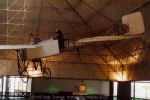
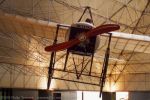
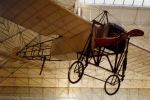
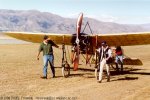
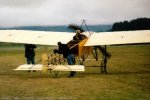
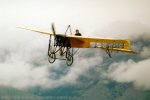
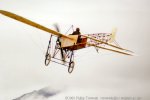



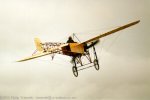


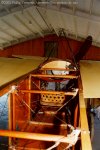

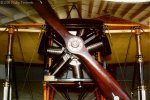
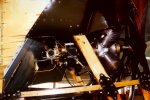
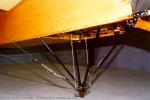
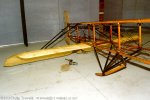
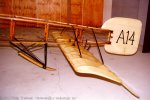
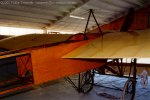
 © 2001 Phillip Treweek, all rights reserved
© 2001 Phillip Treweek, all rights reserved